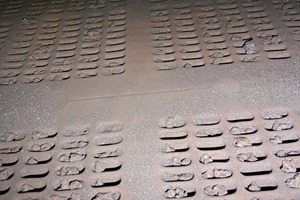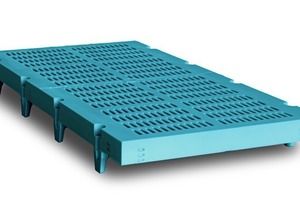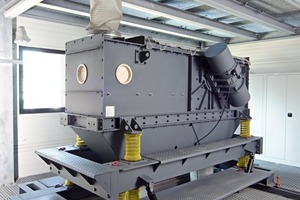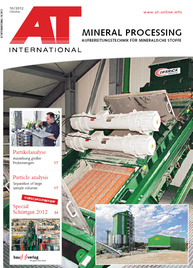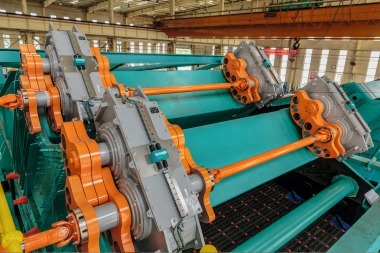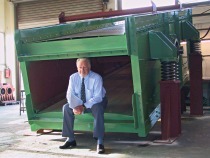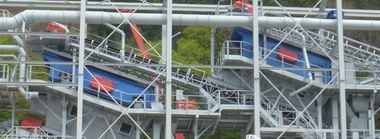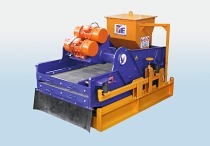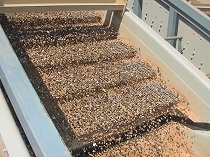Innovations in vibration technology
Schenck Process has been actively involved with vibration technology since 1923. Over the last few years, a steady upwards trend has become apparent in this business, which even the economic crisis in 2009 was not able to halt. The reason for this is the high quality and reliability of the machines. They run for decades, some have even been able to celebrate their “golden anniversary”. Recently, for example, Schenck Process supplied two LinaClass® SLK double-deck screens in the size 3.1 x 8.5 m to India. They were designed for screening coke at a rate of up to 375 t/h and especially to meet special requirements in respect of material moisture during the monsoon season. The total weight per machine is around 50 t.
Another highlight is “The Big Screen”, the biggest Schenck Process sinterscreen ever built. This is a linear-motion vibrating screen of the type LinaClass® SLG, which measuring 4 x 10 m boasts a considerable size and was dispatched on its way to Asia at the end of 2011. It was designed for screening cooled sinter at a rate of 450 t/h, has a total weight of around 65 t and is driven by the largest Schenck Process direct force exciters (2 x DF 604 V) currently available.
In addition to the LinaClass® series, Schenck Process has always relied on its RotaClass® series. The linear- and circular-motion vibrating screens are driven by rugged exciters and cells. They can easily and reliably size ores, coal, pellets, sinter, coke, sand, gravel and chippings in large volumes with high separation sharpness. In addition they are available for special applications, e.g. hot screen for material temperatures to 1100 °C and in different finishes. Linear- and circular-motion screens can reach their limits when it comes to meeting very specialized customer requirements. In such cases, the use of linear- and circular-motion vibrating screens is not suitable as the screen does not remain sufficiently clean, e.g. owing to material being caked to the screen or pegged grain (Fig. 1).
Due to the above mentioned reason, a new vibrating screen – the flip-flow screen – will soon feature in the Schenck Process product portfolio. This extends the spectrum of potential solutions to meet special customer requirements, like screening difficult-to-screen materials. At the beginning of 2013 the first machines of this type are set to go into operation. They will have a single beam suspension, guaranteeing especially easy setting of the operating parameters. In addition, the vibrating elements specially developed for this machine and the cross beams can easily be replaced from outside, making it very service- and maintenance-friendly. The design of the above-mentioned vibrating elements integrates a dust sealing function. Further a screen deck fixing system has been developed, with which the screen mats can be replaced faster and more easily. It also integrates protection against wear on the cross beams.
Almost at the same time, at the Darmstadt site, Schenck Process is developing its own screening surface production. This will complement the screening surface production operations already part of the Schenck Process Group in Australia, Brazil, China and India, and will mainly supply the European region with its own screening surfaces. The screening mats are cast in polyurethane (PU) in the hardness ranges 50 ° to 95 ° Shore A for various applications, like non-metallic minerals or the steel industry (Fig. 2).
The screen mats are manufactured for all available screen deck fixing systems. In addition, with the company’s in-house production, it is possible to optimize the combination of screen and screen deck. Such optimization naturally requires a large number of tests. Precisely for such tests, a TestCenter for vibration technology has been set up at the Darmstadt site (Fig. 3). Here, since January 2012, material and prototype tests have been conducted in order to achieve perfectly coordinated screening processes. Selection of the type of the screening machine is variable, as the equipment is modifiable. The TestCenter was therefore also used for the development of the flip-flow screen. Depending on the customer specifications, the test material is fed by means of a metering belt weigher to the respective screen. This cannot only be variably set to all possible operating parameters, the screening surfaces can also be exchanged as required. Then a detailed analysis is performed to ascertain the screen cleanness in order to determine the optimum operating parameters for the test material.
Thanks to these innovations, Schenck Process is able to offer customers screens to meet very difficult requirements, all from one source starting with technical development, through realization and screen mat manufacture to installation. The know-how extends to the tiniest detail of the machine and guarantees optimally coordinated synergy of the various components.

